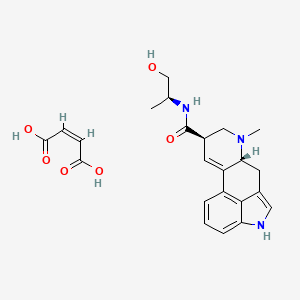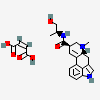Ergonovine Maleate
- Ergonovine maleate
- ergometrine maleate
- 129-51-1
- Cornocentin
- Ermetrin
- Create:2006-04-28
- Modify:2025-01-11

- Ergobasin
- Ergometrin
- Ergometrine
- Ergometrine Maleate
- Ergonovine
- Ergonovine Maleate
- Ergotrate
- Ergonovine maleate
- ergometrine maleate
- 129-51-1
- Cornocentin
- Ermetrin
- Metriclavin
- Ergomet
- Crude ergot
- Ergometrine hydrogen maleate
- Ergotocin maleate
- Ergometrin maleate
- D-Ergonovine maleate
- Ermetrine
- Ergometrine maleate (1:1)
- Ergometrine acid maleate
- Ergotrate Maleate
- Ergonovine hydrogen maleate
- Ergonovine, maleate (1:1)
- UNII-YMH3D0ZJWV
- YMH3D0ZJWV
- Ergonovine maleate [USP]
- EINECS 204-953-5
- Ergonovine, maleate (1:1) (salt)
- NSC 93752
- ergometrin acid maleate
- Ergometrini hydrogenomaleas
- NSC-93752
- Ergonovine maleate (USP)
- ERGONOVINE MALEATE [MI]
- CHEBI:31554
- ERGOMETRINE MALEATE [JAN]
- ERGONOVINE MALEATE [VANDF]
- ERGOMETRINE MALEATE [MART.]
- ERGONOVINE MALEATE [USP-RS]
- ERGOMETRINE MALEATE [WHO-DD]
- 9,10-Didehydro-N-((S)-2-hydroxy-1-methylethyl)-6-methylergoline-8beta-carboxamide maleate (1:1) (salt)
- ERGOMETRINE MALEATE [EP MONOGRAPH]
- ERGONOVINE MALEATE [USP MONOGRAPH]
- Ergometrine (TN)
- ERGOMETRINE HYDROGEN MALEATE [WHO-IP]
- ERGOMETRINI HYDROGENOMALEAS [WHO-IP LATIN]
- Ergoline-8-beta-carboxamide, 9,10-didehydro-N-((S)-2-hydroxy-1-methylethyl)-6-methyl-, maleate (1:1) (salt)
- Ergoline-8-carboxamide, 9,10-didehydro-N-((1S)-2-hydroxy-1-methylethyl)-6-methyl-, (8beta)-, (2Z)-2-butenedioate (1:1) (salt)
- ERGOMETRINE MALEATE (MART.)
- ERGONOVINE MALEATE (USP-RS)
- (6aR,9R)-N-[(2S)-1-hydroxypropan-2-yl]-7-methyl-6,6a,8,9-tetrahydro-4H-indolo[4,3-fg]quinoline-9-carboxamide;(Z)-but-2-enedioic acid
- 9,10-didehydro-N-((S)-2-hydroxy-1-methylethyl)-6-methylergoline-8beta-carboxamide maleate (1:1)
- ERGOMETRINE MALEATE (EP MONOGRAPH)
- ERGONOVINE MALEATE (USP MONOGRAPH)
- N-[(2S)-1-hydroxypropan-2-yl]-6-methyl-9,10-didehydroergoline-8beta-carboxamide (2Z)-but-2-enedioate
- (8R)-N-((1S)-2-Hydroxy-1-methylethyl)-6-methyl-9,10-didehydroergoline-8-carboxamide monomaleate
- (8R)-N-[(1S)-2-Hydroxy-1-methylethyl]-6-methyl-9,10-didehydroergoline-8-carboxamide monomaleate
- (8S)-N-((1S)-2-Hydroxy-1-methylethyl)-6-methyl-9,10-didehydroergoline-8-carboxamide monomaleate
- (8S)-N-[(1S)-2-Hydroxy-1-methylethyl]-6-methyl-9,10-didehydroergoline-8-carboxamide monomaleate
- 9,10-Didehydro-N-[(S)-2-hydroxy-1-methylethyl]-6-methylergoline-8beta-carboxamide maleate (1:1) (salt)
- N-((2S)-1-hydroxypropan-2-yl)-6-methyl-9,10-didehydroergoline-8beta-carboxamide (2Z)-but-2-enedioate
- Ergometrine maleate (JP17)
- Ergometrine maleate (JP18)
- SCHEMBL317356
- CHEMBL1213135
- YREISLCRUMOYAY-IIPCNOPRSA-N
- 1ST10461
- Ergoline-8-carboxamide, 9,10-didehydro-N-(2-hydroxy-1-methylethyl)-6-methyl-, (8beta(S))-, (Z)-2-butenedioate (1:1) (salt)
- NS00079304
- D01163
- Q27114403
- Ergometrine maleate, European Pharmacopoeia (EP) Reference Standard
- Ergonovine maleate, United States Pharmacopeia (USP) Reference Standard
- 9,10-DIDEHYDRO-N-((S)-2-HYDROXY-1-METHYLETHYL)-6-METHYLERGOLINE-8.BETA.-CARBOXAMIDE MALEATE (1:1) (SALT)

H301 (97.5%): Toxic if swallowed [Danger Acute toxicity, oral]
H311 (95%): Toxic in contact with skin [Danger Acute toxicity, dermal]
H331 (95%): Toxic if inhaled [Danger Acute toxicity, inhalation]
P261, P262, P264, P270, P271, P280, P301+P316, P302+P352, P304+P340, P316, P321, P330, P361+P364, P403+P233, P405, and P501
(The corresponding statement to each P-code can be found at the GHS Classification page.)
Aggregated GHS information provided per 40 reports by companies from 3 notifications to the ECHA C&L Inventory. Each notification may be associated with multiple companies.
Information may vary between notifications depending on impurities, additives, and other factors. The percentage value in parenthesis indicates the notified classification ratio from companies that provide hazard codes. Only hazard codes with percentage values above 10% are shown.
Acute Tox. 3 (97.5%)
Acute Tox. 3 (95%)
Acute Tox. 3 (95%)
IMAP assessments - Ergoline-8-carboxamide, 9,10-didehydro-N-(2-hydroxy-1-methylethyl)-6-methyl-, [8.beta.(S)]-, (Z)-2-butenedioate (1:1) (salt): Environment tier I assessment
IMAP assessments - Ergoline-8-carboxamide, 9,10-didehydro-N-(2-hydroxy-1-methylethyl)-6-methyl-, [8.beta.(S)]-, (Z)-2-butenedioate (1:1) (salt): Human health tier I assessment
Patents are available for this chemical structure:
https://patentscope.wipo.int/search/en/result.jsf?inchikey=YREISLCRUMOYAY-IIPCNOPRSA-N
- Australian Industrial Chemicals Introduction Scheme (AICIS)Ergoline-8-carboxamide, 9,10-didehydro-N-(2-hydroxy-1-methylethyl)-6-methyl-, [8.beta.(S)]-, (Z)-2-butenedioate (1:1) (salt)https://services.industrialchemicals.gov.au/search-assessments/
- CAS Common ChemistryLICENSEThe data from CAS Common Chemistry is provided under a CC-BY-NC 4.0 license, unless otherwise stated.https://creativecommons.org/licenses/by-nc/4.0/Ergonovine maleatehttps://commonchemistry.cas.org/detail?cas_rn=129-51-1
- ChemIDplusErgonovine maleate [USP]https://pubchem.ncbi.nlm.nih.gov/substance/?source=chemidplus&sourceid=0000129511ChemIDplus Chemical Information Classificationhttps://pubchem.ncbi.nlm.nih.gov/source/ChemIDplus
- European Chemicals Agency (ECHA)LICENSEUse of the information, documents and data from the ECHA website is subject to the terms and conditions of this Legal Notice, and subject to other binding limitations provided for under applicable law, the information, documents and data made available on the ECHA website may be reproduced, distributed and/or used, totally or in part, for non-commercial purposes provided that ECHA is acknowledged as the source: "Source: European Chemicals Agency, http://echa.europa.eu/". Such acknowledgement must be included in each copy of the material. ECHA permits and encourages organisations and individuals to create links to the ECHA website under the following cumulative conditions: Links can only be made to webpages that provide a link to the Legal Notice page.https://echa.europa.eu/web/guest/legal-noticeErgometrine hydrogen maleatehttps://echa.europa.eu/substance-information/-/substanceinfo/100.004.504Ergometrine hydrogen maleate (EC: 204-953-5)https://echa.europa.eu/information-on-chemicals/cl-inventory-database/-/discli/details/23574
- FDA Global Substance Registration System (GSRS)LICENSEUnless otherwise noted, the contents of the FDA website (www.fda.gov), both text and graphics, are not copyrighted. They are in the public domain and may be republished, reprinted and otherwise used freely by anyone without the need to obtain permission from FDA. Credit to the U.S. Food and Drug Administration as the source is appreciated but not required.https://www.fda.gov/about-fda/about-website/website-policies#linkingERGONOVINE MALEATEhttps://gsrs.ncats.nih.gov/ginas/app/beta/substances/YMH3D0ZJWV
- CCSbaseCCSbase Classificationhttps://ccsbase.net/
- ChEBIErgometrine maleatehttps://www.ebi.ac.uk/chebi/searchId.do?chebiId=CHEBI:31554
- Open TargetsLICENSEDatasets generated by the Open Targets Platform are freely available for download.https://platform-docs.opentargets.org/licenceERGONOVINE MALEATEhttps://platform.opentargets.org/drug/CHEMBL1213135
- ChEMBLLICENSEAccess to the web interface of ChEMBL is made under the EBI's Terms of Use (http://www.ebi.ac.uk/Information/termsofuse.html). The ChEMBL data is made available on a Creative Commons Attribution-Share Alike 3.0 Unported License (http://creativecommons.org/licenses/by-sa/3.0/).http://www.ebi.ac.uk/Information/termsofuse.htmlChEMBL Protein Target Treehttps://www.ebi.ac.uk/chembl/g/#browse/targets
- ClinicalTrials.govLICENSEThe ClinicalTrials.gov data carry an international copyright outside the United States and its Territories or Possessions. Some ClinicalTrials.gov data may be subject to the copyright of third parties; you should consult these entities for any additional terms of use.https://clinicaltrials.gov/ct2/about-site/terms-conditions#Use
- EU Clinical Trials Register
- KEGGLICENSEAcademic users may freely use the KEGG website. Non-academic use of KEGG generally requires a commercial licensehttps://www.kegg.jp/kegg/legal.htmlAnatomical Therapeutic Chemical (ATC) classificationhttp://www.genome.jp/kegg-bin/get_htext?br08303.kegTarget-based classification of drugshttp://www.genome.jp/kegg-bin/get_htext?br08310.kegDrugs listed in the Japanese Pharmacopoeiahttp://www.genome.jp/kegg-bin/get_htext?br08311.keg
- NCI Thesaurus (NCIt)LICENSEUnless otherwise indicated, all text within NCI products is free of copyright and may be reused without our permission. Credit the National Cancer Institute as the source.https://www.cancer.gov/policies/copyright-reuseNCI Thesaurushttps://ncit.nci.nih.gov
- Springer Nature
- Wikidataergonovine maleatehttps://www.wikidata.org/wiki/Q27114403
- Medical Subject Headings (MeSH)LICENSEWorks produced by the U.S. government are not subject to copyright protection in the United States. Any such works found on National Library of Medicine (NLM) Web sites may be freely used or reproduced without permission in the U.S.https://www.nlm.nih.gov/copyright.html
- PubChem
- GHS Classification (UNECE)GHS Classification Treehttp://www.unece.org/trans/danger/publi/ghs/ghs_welcome_e.html
- NORMAN Suspect List ExchangeLICENSEData: CC-BY 4.0; Code (hosted by ECI, LCSB): Artistic-2.0https://creativecommons.org/licenses/by/4.0/NORMAN Suspect List Exchange Classificationhttps://www.norman-network.com/nds/SLE/
- MolGenieMolGenie Organic Chemistry Ontologyhttps://github.com/MolGenie/ontology/
- PATENTSCOPE (WIPO)SID 388333232https://pubchem.ncbi.nlm.nih.gov/substance/388333232
- NCBI


 CID 443884 (Ergonovine)
CID 443884 (Ergonovine) CID 444266 (Maleic Acid)
CID 444266 (Maleic Acid)